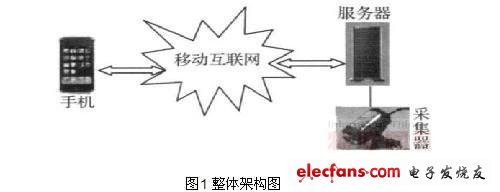1 Introduction
Through the combination of the wireless network and the Internet, the mobile monitoring system of the mobile phone transmits the video signal of the monitoring equipment through the mobile internet to realize real-time online monitoring of the scene. This article uses Sprite of J2ME to display the live monitoring pictures transmitted by the server with the effect of animation, and simulate video monitoring to meet the requirements of real-time video monitoring.
2 System design
The mobile monitoring system for mobile phones is composed of four main parts: video collector, server, mobile Internet and mobile phone. The overall architecture is shown in Figure 1.

System functions: 1) Video image encoding and coding, store the image acquired by the video collector on the server in an appropriate encoding format; 2) Image transmission, when the user sends a request to the server, the server sends the collected image according to the request To the user's mobile phone terminal, the datagram is used for transmission; 3) The display of the image. After the mobile phone terminal obtains the image, if it is not an abnormal situation, the image is displayed in a static manner. If it is an abnormal situation, the mobile terminal is displayed in the form of animation Image and video; 4) Other auxiliary functions, such as abnormal alarm, access permission setting, video capture, monitoring equipment control and other functions.
System work flow: The video collector collects and transmits the on-site situation to the server. After receiving the collected data, the server processes the data and saves it in the database in time. At the same time, it waits for the connection access of the mobile phone. If the mobile phone sends a request, the server The collected on-site situation is transmitted to the mobile phone terminal through the mobile Internet, so that the user can monitor the on-site situation. Considering the actual network traffic and other issues, and the scene (user's home or office) has no abnormal conditions, it is in the same state, so the monitoring system only needs to send a scene key frame picture to the user's mobile phone, only when there is an abnormal situation on the scene The monitoring system will warn the user, and then continuously send the scene on the user's mobile phone in the form of key frame pictures according to the user's requirements, and the user's mobile phone will display the live pictures to the user in the form of animation effects through J2ME Sprite. Real-time video surveillance on site and save network traffic.
Server-side design: The server-side runs on a remote computer and is implemented by J2SE. Its main function is to capture and save on-site monitoring data. The specific steps are as follows: 1) Obtain the address of the video collector; 2) Enter the video sequence collected by the video collector into the data pool; 3) The server uses an appropriate key frame algorithm to extract the corresponding key frame from the video sequence ; 4) According to the client's request to send the corresponding key frame picture data.
Design of the client: The main function of the client is to display the live monitoring pictures transmitted by the server through the animation effect, simulate video playback, and realize real-time video monitoring on the spot. Its hardware requirements:
As a monitoring mobile phone, there are no special requirements in this system, only need to support M IDP 2.0 (currently mobile phones have generally supported M IDP 2.0).
3 Implementation of the system
3. 1 server-side implementation
The system server platform uses Apache Tom ca.t For server-side implementation, this article mainly discusses how to perform server-side network connection and image data transmission. The codes involved are Server. Java and Sender. Java. Server. Java is used to establish a server-side connection, accept the client ’s request, obtain the client ’s address based on the client ’s datagram, and then transmit the processed field information from the collector to the user in the form of a picture by SSender. Java Mobile terminal.

Track for light can help Track Light work, have the track for light, LED track lights can move in track, can change the direction of light, in order to increase the flexibility and high color rendering of lamplight, it is applicable to the exhibition hall, museum, outdoor, edges and corners of the roof light, the dot effect projection, the museum of art and the office of local lighting, etc., are widely used in shopping mall, bar ambry exhibits at the same time the lights. LEDER has a variety of tracks and colors to choose from for the best visual effect.
Track For Light
Modern Track Lighting,Kitchen Track Lighting,Track Lighting Heads,Flexible Track Lighting
JIANGMEN LEDERLIGHT TRADING Co.,LTD , https://www.lederlight.com